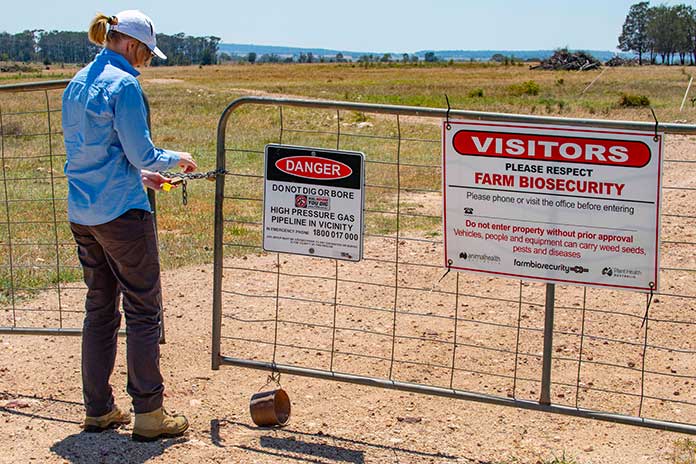
Poultry industries in the United States (U.S.) have been in a unique situation after the 2014-2015 highly pathogenic avian influenza (HPAI) outbreak. Analysis and epidemiology of the outbreak published in the USDA final report indicated most cases were introduced by farm-to-farm
spread. Increased biosecurity within a system and on-farm is a logical solution to preventing or reducing a future introduction of HPAI. As a result, the poultry industries and raised-for-release game birds are embarking in a completely new regulatory process that can, and will, set a precedence for universal biosecurity practices in all of animal agriculture. Through the National Poultry Improvement Plan (NPIP), poultry is the first in animal agriculture to require a written biosecurity plan in order to be eligible for indemnity for any future incident of HPAI in the U.S. Further information about how, and why, NPIP Biosecurity Plans, and their biennial audit, have become required for a portion of poultry operations can be found online at www.PoultryImprovement.org or from your processor or attending veterinarian.
It is human nature to stray away from talking about, or planning for, potentially devastating events. A Foreign Animal Disease (FAD) outbreak, like HPAI, is justifiably one of those occasions. However, writing a biosecurity plan is not only to help you prepare for an outbreak, but also a way to help you, and those you employ, practice standardized principles every time you enter a farm premise to care for or manage birds. Your biosecurity plan is simply a written form of the work and precautions you perform every day. Farms that meet the annual production rates have until August of 2020 to successfully complete their initial audit.
There are several resources available to help you navigate the process of writing your biosecurity in order to have a successful, foundational biosecurity plan and audit. The first resource is an online learning center created by the University of Minnesota Extension. There are NPIP documents, record-keeping templates, explanations of each biosecurity principle, and how-to tips for creating your written plan included in this resource. The learning center can be accessed at http://www.z.umn.edu/NPIP. A main menu allows easy access to any document or module at any time throughout your navigation. First, become familiar with official NPIP Biosecurity Documents. Direct links to NPIP will provide you with official documents and processes. A six-minute video is provided to explain how to get started.
Record keeping templates are available as a module in the UMN learning center. Record keeping is a large component of an effective biosecurity plan and is a necessary part of the NPIP audit. The key to successful record keeping is having a system that you and your employees (if you have them) are going to maintain. Extension personnel worked in partnership with the Minnesota Board of Animal Health to develop six recording keeping templates to use as a guide, or a starting point. If writing things down in a pocket notebook, or on a wall calendar, works for you, fantastic! You are keeping record of your farm activities, and that is what is important. Those records will need to be included in your biosecurity plan audit documents.
The USDA through the Center of Food Security & Public Health at Iowa State University released their own comprehensive resource in December 2018 for those that prefer more in-depth information. The website content is based on a self-assessment of biosecurity on poultry farms, directed by the NPIP standards. This compiled information, found at www.PoultryBiosecurity.org, includes guidance documents for writing a biosecurity plan, how to document biosecurity, signage on your premises and training materials. A popular feature of this resource is the ability to complete a fill-in-the-blank biosecurity plan.
A third resource is the Poultry Disease Planning Tool: originally launched only in Minnesota in 2016, this tool has been expanded and is available nation-wide. This tool was developed to be an easy to use, universally accessible online tool to reach farmers and better prepare them for emergencies. The goal of the tool is to allow farmers to make site-specific profiles that record and organize information that is needed during an emergency. Each site profile is highly secure and includes farm location, equipment available on site, mapping functions and other necessary information needed by first responders. Visit www.PoultryDiseasePlanning.com to get started.
One of the added features is a biosecurity planning module that will help producers plan and implement biosecurity on their premises and provide a link between responders should there be an emergency on site. Using the Poultry Disease Planning Tool will allow a user to input all information regularly. With a few clicks and appropriate authorization, the tool will send a formatted biosecurity plan directly to the OSA for a biennial audit.
Writing your biosecurity plan and preparing for an NPIP Biosecurity Plan Audit is not a task that can be done in a day’s time. It will take time to collect, organize and prepare materials satisfactorily to pass an audit. If you have yet to begin the process, I challenge you to begin by month’s end to familiarize yourself with the 14 principles. Any of the resources mentioned here are suitable at providing information you need to proceed. To make the work more digestible, work on one principle at a time. Provide details of your present procedures and tasks for each, and be certain to answer each of the questions listed in blue text on the NPIP Biosecurity Principles Audit Guidelines. The actual audit of your biosecurity plan will differ state to state.
Take the time to learn what needs to be included in your biosecurity plan. Make the time to write a thoughtful plan and provide supporting documents. Use the resources available to optimize the effectiveness of your biosecurity plan and to ensure the success of your foundational NPIP Biosecurity Plan Audit.
References are available on request
From the Proceedings of 2019 Midwest Poultry Federation Convention

















